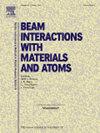Cluster ion beam irradiation at low energy and surface pattern formation
IF 1.4
3区 物理与天体物理
Q3 INSTRUMENTS & INSTRUMENTATION
Nuclear Instruments & Methods in Physics Research Section B-beam Interactions With Materials and Atoms
Pub Date : 2025-04-04
DOI:10.1016/j.nimb.2025.165707
引用次数: 0
Abstract
Ion beam sputtering is a solid-surface nanostructuring procedure. In this work, we are interested in studying the formation of surface patterns during this process. To do this, a Cobalt metal surface is bombarded with clusters at oblique incidence. Cluster bombardment is used since clusters accentuate the effect of surface ripple formation. Two processes explain the effect of pattern formation at the collisional level when diffusion phenomena can be neglected, namely sputtering and atomic redistribution. In the present work, the effect of the energy of the cluster atoms and the surface orientation on the above processes and, therefore, on the surface pattern formation, are analyzed. In the case of energy, it is found that this represents an additional excitation to the formation of patterns. Therefore, if it increases, the surface irregularities increase in turn. However, the specific weight of the processes that support the process is maintained. On the contrary, the crystallographic structure can affect this specific weight. In fact, the formation of patterns on the (100) surface is justified by sputtering regardless of the angle of incidence.
低能簇束离子束辐照与表面图案形成
离子束溅射是一种固体表面纳米结构的制备方法。在这项工作中,我们感兴趣的是研究在这个过程中表面图案的形成。为了做到这一点,钴金属表面被斜入射的簇轰击。使用簇轰击,因为簇加强了表面波纹形成的影响。当扩散现象可以忽略时,两个过程解释了碰撞水平上图案形成的影响,即溅射和原子重分布。在本工作中,分析了簇原子的能量和表面取向对上述过程的影响,从而对表面图案形成的影响。在能量的情况下,发现这代表了图案形成的额外激发。因此,如果它增加,则表面不规则性依次增加。然而,支持该过程的过程的特定权重得到了维护。相反,晶体结构会影响这一比重。事实上,无论入射角如何,在(100)表面上形成图案都是通过溅射来证明的。
本文章由计算机程序翻译,如有差异,请以英文原文为准。
求助全文
约1分钟内获得全文
求助全文
来源期刊
CiteScore
2.80
自引率
7.70%
发文量
231
审稿时长
1.9 months
期刊介绍:
Section B of Nuclear Instruments and Methods in Physics Research covers all aspects of the interaction of energetic beams with atoms, molecules and aggregate forms of matter. This includes ion beam analysis and ion beam modification of materials as well as basic data of importance for these studies. Topics of general interest include: atomic collisions in solids, particle channelling, all aspects of collision cascades, the modification of materials by energetic beams, ion implantation, irradiation - induced changes in materials, the physics and chemistry of beam interactions and the analysis of materials by all forms of energetic radiation. Modification by ion, laser and electron beams for the study of electronic materials, metals, ceramics, insulators, polymers and other important and new materials systems are included. Related studies, such as the application of ion beam analysis to biological, archaeological and geological samples as well as applications to solve problems in planetary science are also welcome. Energetic beams of interest include atomic and molecular ions, neutrons, positrons and muons, plasmas directed at surfaces, electron and photon beams, including laser treated surfaces and studies of solids by photon radiation from rotating anodes, synchrotrons, etc. In addition, the interaction between various forms of radiation and radiation-induced deposition processes are relevant.

 求助内容:
求助内容: 应助结果提醒方式:
应助结果提醒方式:


